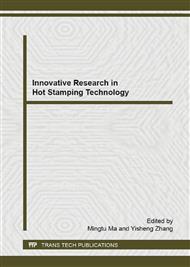p.151
p.169
p.177
p.181
p.186
p.190
p.194
p.198
p.202
Investigation of Mechanical Property and Springback Behavior with Hot Stamping RCP Process
Abstract:
With the current development of hot stamping technology, quality products have been striving for not only uniformity in hardness but also a minimum of springback. Considering the fact that the uniformity distribution of hardness and the randomness distribution of the springback are inevitable in hot stamping process due to many complex factors such as contact sequence, contact clearance, scale and initial stamping temperature, a new method named RCP method was proposed to improve the hardness and springback of hot stamping product in this paper. The cooling rate control before stamping is applied based on CCT curves through a rapid air cooling device which can provide cooling rate of 60°C/s. Three parameters included initial stamping temperature, contacting pressure and dwelling time have been investigated in this paper. According to the experiment results, the hardness deviation is markedly decreased and the springback can be controlled within the threshold value ±0.5mm.
Info:
Periodical:
Pages:
186-189
Citation:
Online since:
December 2014
Authors:
Keywords:
Price:
Сopyright:
© 2015 Trans Tech Publications Ltd. All Rights Reserved
Share:
Citation:


